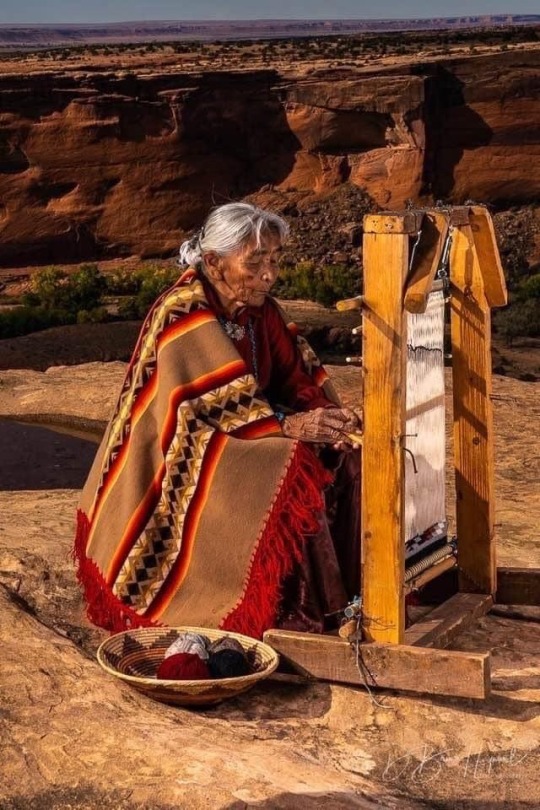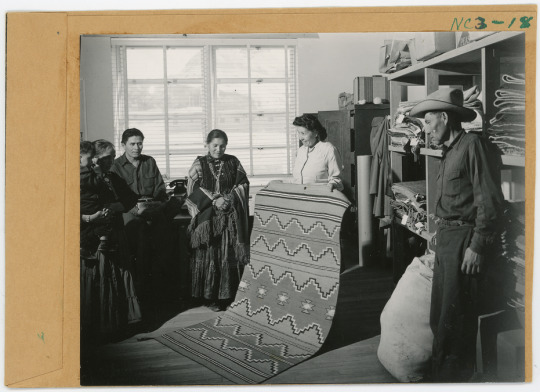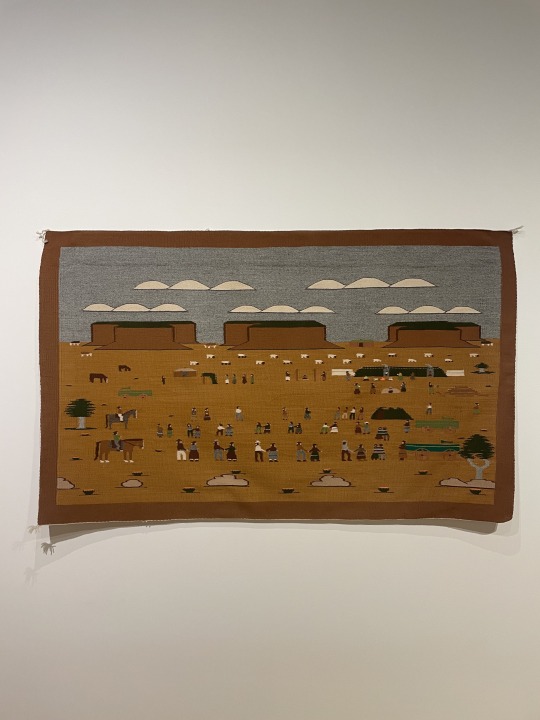#Navajo weaving
Explore tagged Tumblr posts
Text

Winter Solstice 2024
It is cold and it is dark, but the Winter Solstice brings the promise of light's return and the warming of our world. To celebrate this most important day, we feature a naturally-dyed wool weaving entitled Náhookǫsji Hai (Winter in the North) / Biboon Giiwedinong (It is Winter in the North) held at the Minneapolis Institute of Art (MIA) and produced by Navajo artist D. Y. Begay in 2018. This image, which is only a portion of the slightly larger work, is from our copy of the exhibition catalog Hearts of Our People: Native Women Artists edited by Jill Ahlberg Yohe and Teri Greeves (Kiowa) and published by the MIA in association with the University of Washington Press in 2019.
D.Y. Begay (b. 1953), a Navajo born to the Totsohni’ (Big Water) Clan and born for the Tachinii’ (Red Running into Earth) Clan, is a fourth-generation weaver. Begay’s tapestries encompass her interpretation of the natural beauty and descriptive colors of the Navajo reservation, reflecting on her Navajo identity and her family’s weaving tradition. This spiritual connection to the plants yields the natural colors that are transformed into evocative land formations on her loom. Of the weaving shown here, Jennifer McLerran, curator at the Museum of Northern Arizona and a retired assistant professor of art history at Northern Arizona University, writes:
Most of D. Y. Begay's textiles respond to the Southwest landscape in which she was raised and resides today. For this work, a textile produced with all-natural dyes and handspun wool, Begay traveled to Minnesota in the depths of winter to observe the land surrounding the Grand Portage Indian Reservation of the Ojibwe people. Over an extended period she observed changing light conditions as the sun and clouds moved across the sky, altering the hues of snow and water.

D. Y. Begay with her weaving Confluence of Lavender by Arizona videographer Kelso Meyer, 2016. From the University of Virginia Mellon Indigenous Arts Program.
We wish you a most serene Winter Solstice.
View posts from Winter Solstices past.
View other posts from our Native American Literature Collection.
#Winter Solstice#D. Y. Begay#Winter in the North#Navajo weaving#Navajo textiles#Indigenous artists#Navajo#Ojibwe#textiles#Native American artists#Native Americans#Indigenous#indigeneity#Jill Ahlberg Yohe#Teri Greeves#Jennifer McLerran#Hearts of Our People: Native Women Artists#Native American Literature Collection#Indigenous American Literature Collection#Native American art#Indigenous art
274 notes
·
View notes
Text

#beyond the adobe#western living#western style#southwestern#cowboy life#ranch life#boho western#santa fe#shiprock gallery#navajo weaving
48 notes
·
View notes
Text

126 notes
·
View notes
Text
TahNibaa Naataanii
youtube
Textile artist TahNibaa Naataanii was born in 1967 in Shiprock, New Mexico. Naataanii is a traditional Navajo weaver with deep knowledge of her culture's weaving process. Her art has been displayed in US embassies throughout the world, and in 2022, she was honored with a Heritage Fellowship from the National Endowment for the Arts.
#art#artists#native american#navajo#indigenous#indigenous art#native art#weaving#textile art#navajo weaving#american indian#native women#indigenous women#Youtube
19 notes
·
View notes
Text
Article is Very worth reading, don’t let the long section at the beginning about a rug put you off.


#navajo weaving#marilou schultz#intel pentium#national gallery of art#american indian movement#race in the us#race in america#navajo#navajo nation#electronics manufacturing#a bigger history#textiles#rug#native american
20K notes
·
View notes
Text







The first major solo museum presentation of fourth-generation Navajo weaver Melissa Cody (b. 1983, No Water Mesa, Arizona) spans the last decade of her practice, showcasing over 30 weavings and a major new work produced for the exhibition. Using long-established weaving techniques and incorporating new digital technologies, Cody assembles and reimagines popular patterns into sophisticated geometric overlays, incorporating atypical dyes and fibers. Her tapestries carry forward the methods of Navajo Germantown weaving, which developed out of the wool and blankets that were made in Germantown, Pennsylvania and supplied by the US government to the Navajo people during the forced expulsion from their territories in the mid-1800s. During this period, the rationed blankets were taken apart and the yarn was used to make new textiles, a practice of reclamation which became the source of the movement. While acknowledging this history and working on a traditional Navajo loom, Cody’s masterful works exercise experimental palettes and patterns that animate through reinvention, reframing traditions as cycles of evolution. Melissa Cody is a Navajo/Diné textile artist and enrolled member of the Navajo/Diné nation. Cody grew up on a Navajo Reservation in Leupp, Arizona and received a Bachelor’s degree in Studio Arts and Museum Studies from Institute of American Indian Arts, Santa Fe. Her work has been featured in The Barnes Foundation, Philadelphia (2022); Crystal Bridges Museum of American Art, Bentonville, AR (2021); National Gallery of Canada, Ottawa (2019–2020); Museum of Northern Arizona, Flagstaff (2019); SITE Santa Fe (2018–19); Ingham Chapman Gallery, University of New Mexico, Albuquerque (2018); Navajo Nation Museum, Window Rock (2018); and the Museum of Contemporary Native Arts, Institute of American Indian Arts, Santa Fe (2017–18). Cody’s works are in the collections of the Stark Museum of Art, Orange, Texas; the Minneapolis Institute of Arts; and The Autry National Center, Los Angeles. In 2020, she earned the Brandford/Elliott Award for Excellence in Fiber Art.
Melissa Cody: Webbed Skies currently on exhibition at MoMA PS1 through September 9nth, 2024
IDs Under the cut
Top to Bottom, Left to Right: White Out. 2012. 3-ply aniline dyed wool. 17 × 24″ (43.2 × 61 cm)
Deep Brain Stimulation. 2011. Wool warp, weft, selvedge cords, and aniline dyes. 40 x 30 3/4 in. (101.6 x 78.1 cm)
World Traveler. 2014. Wool warp, weft, selvedge cords, and aniline dyes. 90 x 48 7/8 in. (228.6 x 124.1 cm)
Into the Depths, She Rappels. 2023. Wool warp, weft, selvedge cords, and aniline dyes. 87 x 51 9/16 in. (221 x 131 cm)
Lightning Storm. 2012. 3-ply aniline dyed wool. 14 × 20″ (35.6 × 50.8 cm)
Pocketful of Rainbows. 2019. Wool warp, weft, selvedge cords, and aniline dyes. 19 x 10 3/4 in. (48.3 x 27.3 cm)
Path of the Snake. 2013. 3-ply aniline dyed wool. 36 × 24″ (91.4 × 61 cm)
265 notes
·
View notes
Text

Marilou Schultz. Replica of a Chip, 1994.
wool mounted on wood
10 notes
·
View notes
Text
Show me your threads
Your blue thread
Your sun-weave thread
Your mud thread
Your mica thread
Your tenzontle net
Your fire smoke braid
Your water serpent net
Your falls below thread
Your smoke hairs
Grass braid
Tender corn braid
Maguey needle thread
A tight braid
A firm net to catch
Red healing hoops
To thread through the story
And wrap around
Turtle's Back
- from Patrisia Gonzales's 'Red Medicine: Traditional Indigenous Rites of Birthing and Healing

Navajo woman weaving a rug in her hogan
#threads#weaving#folkways#ancient ways#sacred ways#Red Medicine: Traditional Indigenous Rites of Birthing and Healing#Patrisia Gonzales#healing#medicine#Ancestors Alive!#What is Remembered Lives#Ancestral Medicine#Turtle Back#Turtle#Navajo#rug weaving
19 notes
·
View notes
Text

WHITE OUT BY MELISSA CODY (2012)
10 notes
·
View notes
Text

"Replica of a Chip", created by Marilou Schultz, 1994. Wool. Photo taken at the National Gallery of Art, 2024.
I talked with Marilou Schultz, a Navajo/Diné weaver and math teacher, to learn more about the artwork. Schultz learned weaving as a child—part of four generations of weavers—carding the wool, spinning it into yarn, and then weaving it. For the Intel project, she worked from a photograph of the die, marking it into 64 sections along each side so the die pattern could be accurately transferred to the weaving. Schultz used the "raised outline" technique, which gives a three-dimensional effect along borders. One of the interesting characteristics of the Pentium from the weaving perspective is its lack of symmetry, unlike traditional rugs. The Pentium weaving was colored with traditional plant dyes; the cream regions are the natural color of the wool from the long-horned Navajo-Churro sheep.
The rug is accurate enough that each region can be marked with its corresponding function in the real chip, as shown below. Starting in the center, the section labeled "integer execution units" is the heart of the processor, performing arithmetic operations and other functions on integer numbers. The Pentium is a 32-bit processor, so the integer execution unit is a vertical rectangle, 32 bits wide. The horizontal lines correspond to different types of circuitry such as adders, multipliers, shifters, and registers…

—Ken Shirriff
6 notes
·
View notes
Text

The Navajo Arts and Crafts Guild buying rugs in Window Rock, Arizona, on March 27, 1943.
John and Agnez Anderson selling; Marie Martin buying.
Record Group 75: Records of the Bureau of Indian Affairs
Series: Photographs of Navajo Life in the Southwestern Region of the United States
File Unit: Arts and Crafts
Image description: Six people in a room with large shelves along one side. One woman is holding one end of an unfurled woven rug, which has straight horizontal stripes and stepped diagonal stripes in several different colors (well, different shades of gray in this black and white photo). A man in a cowboy hat stands to the side near the shelves, which hold folded rugs. Three adults stand on the other side of the room, looking at the rug; one woman is holding a small child.
#archivesgov#March 27#1943#1940s#Native American history#American Indian history#Indigenous American history#Navajo#Diné#art#craft#rug#weaving
102 notes
·
View notes
Text



Navajo textiles
collection: Vatican Museums
2 notes
·
View notes
Text

#beyond the adobe#western living#western style#southwestern#santa fe#ranch life#boho western#santa fe interiors#cowboy life#navajo weaving#dinetah
55 notes
·
View notes
Text

Here's a pictorial rug I really enjoyed by Isabel John (c. 1975).
I want to start collecting pictorial rugs this year and the next. Hit me up if you can recommend good sites for finding rugs for prices that are fair to the artist and yet which a poor author can afford
2 notes
·
View notes
Photo

Mudroom - Southwestern Entry Inspiration for a mid-sized southwestern ceramic tile entryway remodel with yellow walls and a dark wood front door
#native american bedding#table runners#american indian art#navajo rugs#floor rugs#native american weaving
6 notes
·
View notes
Text
my est. supervisor (an expert in handicrafts) for my ma program has accused me ,,, of ukrainians (in their homeland, not diaspora even) culturally appropriating the technique of bead-weaving from the navajo (specifically) in the 1800s (if not even earlier). there's a lot to unpack here,,, god forbid different cultures come up w the same basic technique (weaving) i guess
#hush vassa#tbd#ur telling me a 19th c ukr peasant learned how to weave from the navajo ???#girlie. there were already looms in ukraine#lets try and do some simple critical thinking#semioticians are fckng unhinged. morons even#idk where to begin on this
3 notes
·
View notes